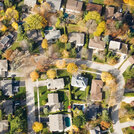
At least 40% canopy coverage is needed to achieve the maximum cooling effect of trees in offsetting the urban heat island effect at the scale of a typical city block, according to this University of Wisconsin-Madison study. To counteract higher temperatures associated with impervious surfaces, canopy cover was most important during the day, while reducing impervious surface area was determined to be important for lowering nighttime temperatures.
Ziter, Carly D., Eric J. Pedersen, Christopher J. Kucharik, and Monica G. Turner. “Scale-Dependent Interactions between Tree Canopy Cover and Impervious Surfaces Reduce Daytime Urban Heat during Summer.” Proceedings of the National Academy of Sciences 116, no. 15 (2019): 7575–80. https://doi.org/10.1073/pnas.1817561116
